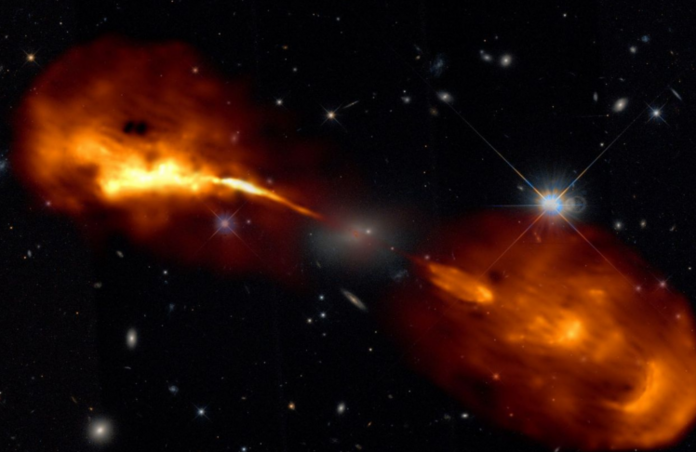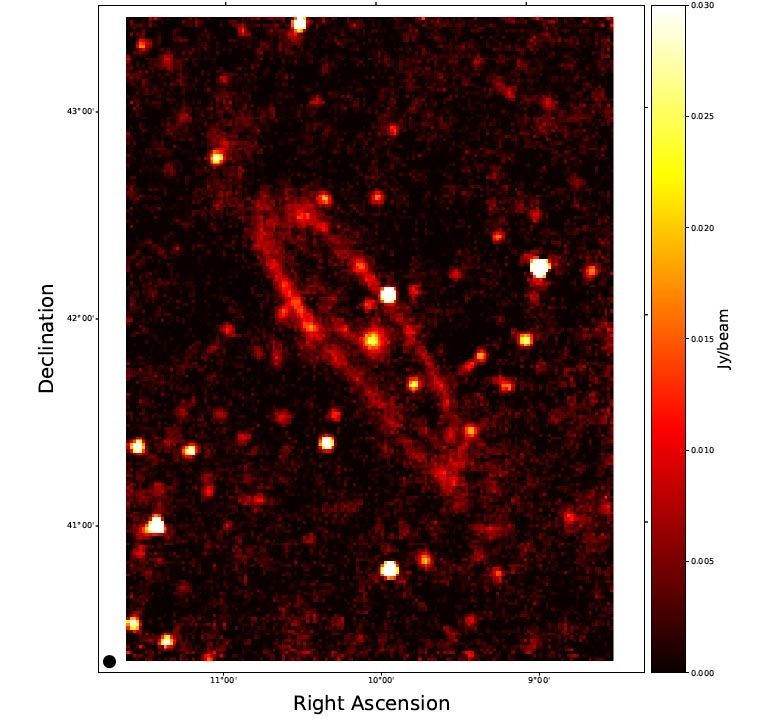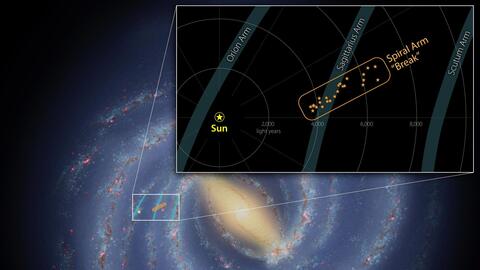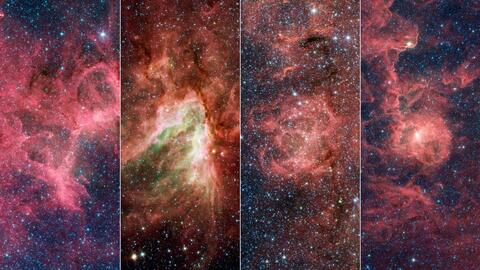New clues about galactic formation from research on galaxies far and near

Multiple recent studies have focused on galaxies to lift the veil on their formation - by looking at their radio lobes, building computer models or even diagnosing a broken spiral arm.
The Low Frequency Array (LOFAR) is the largest network of low-frequency radio telescope, using 70 000 antennas up to 2000 km apart (for the telescopes in Ireland and Poland, expressly). Relativistic particle jets emitted by massive black holes aren’t visible in the optical, which is why radio images are key to help us appreciate what happens around galaxies’ central black holes. Typically, a black hole “eats” material from the accretion disk around it; magnetic field lines can accelerate some of the infalling matter outwards at relativistic speeds, aka approaching the speed of light. This gets referred to as synchrotron emission. As the jets reach and interact with the intergalactic medium, they form immense structures called lobes, or radio lobes as that’s still the wavelengths they emit at.
Optical vs Radio view Some of the radio galaxies
A stunning example of LOFAR’s latest observations is Hercules A, which you can see as the cover image, and which presents a ring structure in its radio lobes. The team’s explanation for this observation is that the jet intermittently intensifies in bursts. Similarly, the structure of 3C 293 suggests that its supermassive black hole undergoes dormant periods when the jet flow gets interrupted. The creation and shaping of the radio jets and lobes are far from understood, but the LOFAR collaboration’s zoom into these radio galaxies is a substantial step forward to probe the extreme environment surrounding the most massive black holes.
These observations coincide with the publishing of an article detailing how state-of-the-art computer modelling could answer the question of the genesis of supermassive black holes. Taking into account an unprecedented number of factors such as the dynamics of the gas, the mechanisms at play when pressure forces or temperatures change, but also feedback from supernova events, the team at the Flatiron Institute Centre for Computational Astrophysics breached the gap between very large-scale and very small-scale simulations. The project is a successor to the Feedback In Realistic Environments (FIRE) project, and increases the resolution of the visualisation that follows the gas’ path to the centre of the galaxy, where the black hole lies.

This is a significant achievement in addressing the issue of quasar formation - these fast-growing supermassive black holes can reach masses of more than 1 billion Suns and outshine entire galaxies, which implies that they must “feed” on incredible amounts of gas. The supercomputer simulation indicates that stars can provoke gravitational unrest that drives gas influx towards the galactic centre, in sufficient quantities to power a quasar. Further tweaks to the computer model will teach us about how things play out under slightly different conditions, whether that’s more gas at the start, less massive stars etc., in order to account for the variety of galaxies, massive black holes and quasars in our Universe.
Back to observations, our closest galactic neighbour the Andromeda Galaxy has also been put in the spotlight thanks to the 64-meter dish Sardinia Radio Telescope in Italy. Obtained at slightly shorter wavelengths than for the distant jets, in the microwave band specifically, the images allowed astronomers to pinpoint the locations where star formation occurs and estimate the rate of the process. While emissions at these frequencies (between 1 GHz to 22 GHz) are very faint, the features they reveal can’t easily be detected otherwise.

This extremely detailed map of Andromeda was produced thanks to new algorithms, capable of separating the thermal emissions due to star formation from background microwave emission sources – a whooping 100 background objects from stars to galaxies were catalogued after further analyses of the image. Furthermore, the team that conducted this study hopes that understanding the structure and physical processes in the Milky Way’s sister galaxy will allow us to comprehend those of the Milky Way itself better.
Speaking of the Milky Way, data taken with NASA’s Spitzer Space Telescope suggests that it may have a broken arm. Actually, what we’re talking about is a 3000 light-years long structure, containing young stars and star-forming regions, that is positioned in a very odd way with respect to the Sagittarius Arm. Although the detachment moves at around the same speed and in the same direction as its host arm, it stands out at an angle of nearly 60°.

Location of the break in the Sagittarius Arm 
Some of the star-forming regions in the broken arm structure
While such “spurs” or “feathers” had previously been observed in other spiral galaxies, it is unknown how forces of gravity and galactic rotation can provoke the separation between a forming spur and the rest of the arm – at the same time, astronomers are still unsure about what causes spiral arms to form in galaxies like the Milky Way. Either way, it’s fascinating to think that a phenomenon that was known to exist in other galaxies has finally been found in our own, as astronomers had been looking for “feathers” in the Milky Way for decades!
Astronomers have a lot of work left before we can fathom how galaxies form - from radio lobes to broken arms, each of them has unique features, which doesn't make the task easier for researchers. At the same time, it means that galaxies are sublime targets for astrophotography!
Cover Image: Hercules A, R. Timmerman; LOFAR & Hubble Space Telescope
Image Credits:
1 - Optical SDSS vs Radio LOFAR, A. Kappes
2 - Distant jets at low frequencies, C. Groeneveld
3 - Distribution of gas across scales, Anglés-Alcázar et al., ApJ 2021
4 - Final image of Andromeda at 6.6 GHz, S. Fatigoni et al., AaA 2021
5 - Spiral Arm Break, NASA/JPL-Caltech
6 - Eagle, Omega, Triffid, and Lagoon Nebulae, NASA/JPL-Caltech
